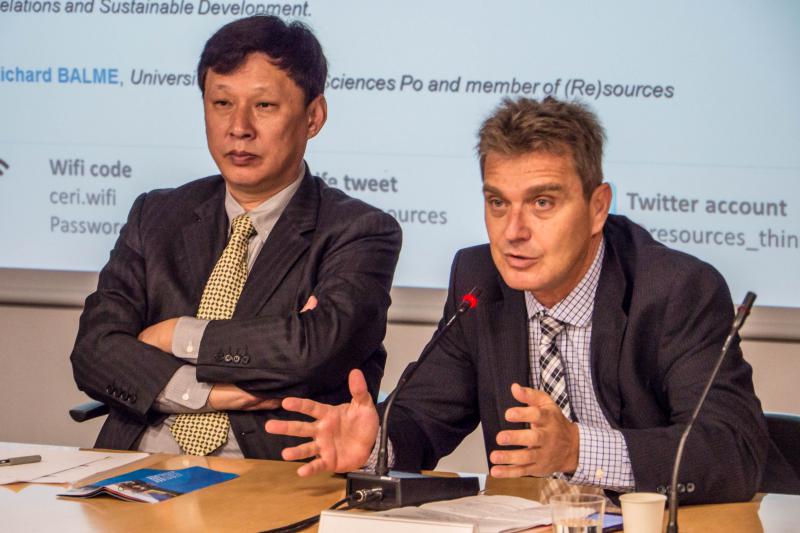LA CRISE DE L’EAU : ENJEU DU XXIEME SIECLE EN CHINE (Paris – 8h30-10h30 – Sciences Po Centre de Recherches Internationales 56, rue Jacob, Paris 6)

Bien que la Chine possède un 5ème des ressources en eau de la planète, celles-ci sont très inégalement réparties et la moyenne de l’eau disponible par habitant est seulement égale au tiers de la moyenne mondiale. Il en résulte un déficit hydrique important qui impacte la sécurité alimentaire du pays. En outre, 40% des rivières chinoises sont très gravement polluées et 800 millions de chinois ne disposent que d’une eau impropre impropre à la consommation. Entre pénurie et pollution, comment la Chine peut-elle relever le défi de l’accès à l’eau ?
Débat avec Dr Kaijun Wang, professeur au département des sciences de l’environnement à l’université de Tsinghua (Chine), Paul Kriss, coordinateur global pour le développement durable des infrastructures urbaines et des services de la Banque Mondiale et ancien coordinateur du secteur Eau et Villes en Chine de la Banque Mondiale et Caroline Jeanmaire, diplômée de Sciences Po et de l’Université de Pékin, spécialisée en développement durable et relations internationales.
Débat animé par Richard Balme, professeur agrégé à Sciences Po et membre de (Re)sources
Matinale organisée en partenariat avec lesrencontres Europe Chine de Sciences Po
L’essentiel du débat (en anglais)
Introduction
- It is often quoted that with a population of 1.3 billion, China has to feed some 20% of the world population with less than 7% of arable land.
- Water accessibility and water quality are extremely serious issues in China. It is reported that 800 million people do not have access to safe water.
- In 2014, groundwater supplies in more than 60 percent of major cities were categorized as “bad to very bad” and more than a quarter of China’s key rivers are “unfit for human contact.”
- China would not be able to continue expanding and developing at the pace it did without taking into account the externalities of water pollution.
General facts
- EU and the USA experienced similar problem with water pollution when they industrialized. The major differences is that EU and USA did not absorb 350 million people into urban area over 30 years
- Agriculture usually take 70% of the water consumption
- China has significantly expanded its water, its waste water services by mandate with the “Five-year Plan”
Technical facts and solutions (Dr Wang presentation)
- Water resource shortage: average water resource is only 2200m3/p and accounts for ¼ of global average and is uneven on time and space.
- Water pollution is serious: about 63.8% of 141 state control river section water quality is belong class IV or worse than V class (Chinese standards)
- We need to explore unconventional water resources as it is an efficient way to solve water scarcity both in sources and for better quality
- After three national “Five-year Plan”, China experienced remarkable fast development in waste water treatment plant building in the past 15 years.
- Industrial water recycling is a important water-saving way to alleviate the water shortage
- Sponge City is an urban development paradigm that enable buildings, roads, green spaces, water system and other ecosystems to play full role to naturally store, infiltrate, detain and treat storm runoff, by strengthening the urban planning and development management.
- Sponge cities is building a technical architecture of ‘Infiltration, Detention, Retention, Purification, Reuse, Discharge’
- In 2015, more than 130 cities applied for a demonstration of sponge city.
- Seawater desalination should be considered as water safety strategy ….. speeding up research for seawater desalination, promoting desalination industry development………
Social media and fighting against water pollution (Caroline Jeanmaire presentation)
- According to a 2015 survey by the Pew Center, 75% of Chinese say water pollution is a very or moderately big problem, making water pollution rank among the top three of public’s concerns.
- Social media provide an adapted platform of interactions between the government, citizens and industries, in support of highly-centralized water pollution policies.
- Indeed, despite the fact that the government’s environmental standards for regulation and laws are meaningful to address water pollution problems, implementation at the local level is deficient.
- These difficulties provide a strategic opening to public participation in the particular field of clean water access, characterized by a new wave of social media use, targeted at fighting water pollution.
- In February 2016, a Chinese government campaign asked the public to hunt down polluted waterways that can be mapped and cleaned up through the widely-used social media of « WeChat ». Since the project started in February 2016, citizens have used smartphones to identify and log more than 1,300 locations.
- The Institute for Political and Environmental Affairs (IPE) is pioneer in fighting water pollution through social media.
- In 2006, the independent Beijing-based NGO created the China Water Pollution Map which provided updated water quality information about all the Chinese provinces and over 300 of its cities.
- More than 3 million users have downloaded the « Pollution Map » application, which displays any area‘s water quality, pollutant discharges and sources of contamination, including information on enterprises and sewage treatment facilities that exceed pollution standards.
- These initiatives are not only about making information available to the public – they also hope to pressure industries in making change and capitalize on the power of citizens to assist in clean-up efforts.
VIDEOS DE L’EVENEMENT
Professor at the Department of Environmental Science and Engineering, Tsinghua University
Paul KRISS, Global Leader for City Infrastructure and Services at the World Bank
Richard Balme, professor at Sciences Po and member of (Re)sources
Caroline Jeanmaire, Science Po and Beijing University graduate

